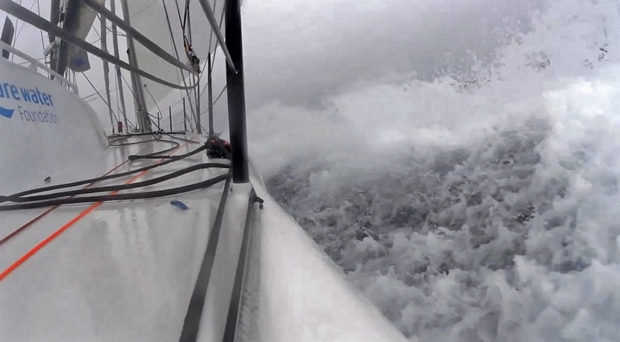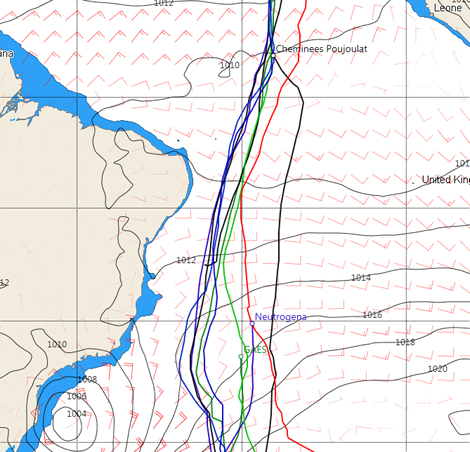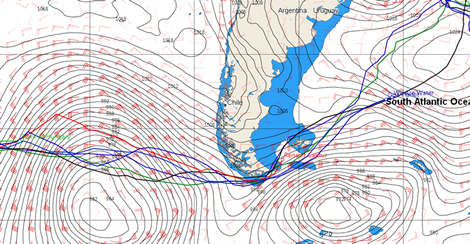60 knot gusts at the Horn
It has been a day of landmarks – both tangible and invisible - for the Barcelona World Race fleet.
For Jörg Riechers and Sébastien Audigane the landmark was very much a physical one, as Cape Horn presented the Renault Captur crew with one of the most fearsome Pacific Ocean farewells in this Barcelona World Race to date.
The pair made their final approach to the tip of South America in 35-40 knot WNWerly winds, with severe gusts topping 60 knots. The German-French duo benefitted from a relatively stable sea state as they rounded the Horn, although shortly afterwards conditions deteriorated with eight metre waves and a very confused sea state.
Images below (click to enlarge) courtesy of Expedition and Predictwind
Renault Captur passed Cape Horn's longitude of 67°17'35W at 11h48 UTC sailing just 2.5 miles off the coast of Tierra del Fuego, Chile. She becomes the sixth boat in the Barcelona World Race to pass the maritime world's most famous landmark. It was a fourth rounding for Frenchman Audigane, who celebrated his 47th birthday yesterday, while for his German co-skipper, 46, it was a first Horn rounding, a hugely significant moment for any ocean racer.
Speaking 24 hours before they approached the Horn, Audigane explained the difficult conditions they had forecast: “Is Cape Horn the road to hell? It could well be that for us. The tropical low to the north of Renault Captur, which has been following us since NZ is in the process of turning into a weather monster. It is running into the Andes, being forced back down south and deepening to 951mb to become a real hurricane.
"For us it’s a race against the clock. If we’re quick enough we’ll get by just losing a few feathers with winds up to 45 to 50 knots and 7m high waves.”
Previewing his fourth rounding of Horn, Audigane highlighted the importance of this legendary Cape: “It is a mythical place for sailors. It was the most southerly waypoint in the maritime routes between New York and San Francisco, for instance. It is the third Cape of the round the world races, a quite particular place, with big depressions lining up, a wild place and quite hostile.”
Renault Captur took 68 days, 23 hours and 47 minutes of racing to reach the southernmost Cape since departing Barcelona on New Year's Eve. This time includes a 48-hour technical pitstop in Wellington.
Speeding across the South Atlantic
Last night race leaders Cheminées Poujoulat crossed the Equator at 2150 UTC, returning to the northern hemisphere on the homeward bound North Atlantic leg.
Bernard Stamm and Jean Le Cam covered approximately 4,000 miles from the tip of South America to the Equator taking just 12 days, 19 hours and 57 minutes - the fastest crossing of the South Atlantic yet by an IMOCA 60 – in the last Barcelona World Race Jean-Pierre Dick and Loick Peyron on Virbac Paprec 3 took 15 days, 1 hour and 50 minutes, while in 2009 solo sailor Francois Gabart completed the same section of ocean in 13 days 19 hours and 21 minutes in the Vendee Globe.
For Le Cam and Stamm, the crossing represents a significant psychological step closer to home. With around 2,800 miles theoretically left to sail, the circumnavigation is far from over, but Le Cam explained that mentally, the final miles of the North Atlantic always seem to pass much more quickly than the equivalent miles of desolate Southern Ocean.
“It’s all good here, it's going to be hot that's for sure, and there’s a lot of mess but it’s the Doldrums so that’s okay. The wind is not yet very stable, that’s the least we can say, but it will become more and more stable as we will find the trade winds from the north. The sea is full of Sargasso weed. And there are very special birds with a long beak, kingfisher-style for catching little green dorades. There are a few above us. It's a sign that there are dorades around and you have made it to the tropics.
“We started in the northern hemisphere and 90% of the course is in the southern hemisphere. But we live in the northern hemisphere, and the start is in the northern hemisphere, so this is a step, a step forward.
“It's nice to be able to stand up. Yesterday, we removed the protective ‘bubble’ as we were like little old men with their backs hunched over completely. It must be 1.20m below the cover, so we are permanently bent. To change position, and not have to cling on to stand as we move, is quite refreshing. And the boat is in good shape, no particular worries, we've already had them and we have got them almost sorted. It’s good.
“I've never done a round the world so quickly, that's for sure already. Bernard has yes, because he did it with Orange II, which is something else entirely.
“We are already at the Equator and then it is always the same: when you have done a world tour and you arrive at Brazil, at the Equator, you have the impression that Europe is next door. When you travel from South Africa to Australia, New Zealand, Argentina, it is still large, long distances and then finally, when you're at the Equator and you see Europe there, just above, and you do routings, you realize that a fortnight later, you're there.”
Tropics and thermals
Elsewhere in the fleet, Neutrogena and GAES Centros Auditivos, second and third placed respectively, are into the trade winds and have seen their boat speeds gradually pick up over the course of the day to average 10 knots.
Fourth and fifth placed We Are Water and One Planet One Ocean Pharmaton remain closely matched – this morning both sailing at over 17 knots. Willy and Bruno Garcia on We Are Water are currently fastest in the fleet, having clocked up a very respectable 370 miles in the past 24 hours.
Seventh-placed Spirit of Hungary is also making similar speeds. Nandor Fa today reported 38-40 knot winds, and 13-22 knot boat speeds in demanding and brutally cold conditions.
“We have quite difficult and tough conditions at the moment,” commented Fa, “Outside there is 38-48 knots of wind from the south-west, and we are making progress but it is really tough sailing. Big waves, very aggressive new waves, and a difficult life on board.”
He and Conrad Colman anticipate arriving at Cape Horn in around five days’ time, when the forecast is for lighter winds and improved conditions. However, Fa, who has rounded Cape Horn three times previously, is not thinking about exiting the South – for this duo who have overcome so many obstacles the Southern Ocean could yet present them with a final challenge.
Fa commented: “We have quite difficult and tough conditions at the moment. Outside there is 38-48 knots of wind from the south-west, and we are making progress but it is really tough sailing. Big waves, very aggressive new waves, and a difficult life on board.
“Basically we are happy because we have good winds and good progress to the east at the moment, towards Cape Horn. But the conditions are quite tough and we are fighting. We have of course small problems all the time in these conditions, but we solve these problems and right now we are sailing with 13-22 knots of speed. This is quite rough and the boat is moving very much, so the life is not easy on board. But anyway, we are okay!
“Right now we have big waves, and since more than a day – one or two days – we have strong-westerly winds and now we have about 4-5 metres of waves. Sometimes the boat lays down, and after this of course you have to keep going.
“If we can follow the weather forecast we would have the same winds for the next two or three days, and maybe a little bit lighter conditions closer to the Cape Horn.
“Fortunately our autopilot is working perfectly and we do not have to go out and hand-steer. It would be very difficult because outside is very cold, the water is very cold and the air also very cold – less than 10 degrees, and freezing cold . So if we are going out for sail changes or any kind of work half an hour is enough in these conditions.
“I feel now that [Cape Horn] is quite far away, about five days, but we expecting lighter winds and better conditions than we have now. But nothing is sure. In twodays or three days we will be able to see much more precisely what we can expect, but I say again as far as we can we can have nice, lighter conditions.
“I don’t think about the end of the South because it’s not the end. When we round Cape Horn we’ll be near the end, but we’re not there.
“Also after Cape Horn around the Falkland Islands can be tough conditions so not only until Cape Horn is passed but a couple of days after the Horn we’ll also be deep in the South and they can be very tough. So I don’t think about how it will end!”
Positions at 1400 UTC
1. Cheminées Poujoulat (B Stamm – J Le Cam) at 2869.2 miles to finish
2. Neutrogena (G Altadill – J Muñoz) + 1447.0 miles to leader
3. GAES Centros Auditivos (A Corbella – G Marin) + 1612.3 miles to leader
4. We Are Water (B Garcia – W Garcia) + 3158.6 miles to leader
5. One Planet One Ocean & Pharmaton (A Gelabert – D Costa) + 3192.8 miles to leader
6. Renault Captur (J Riechers – S Audigane) + 3993.6 miles to leader
7. Spirit of Hungary (N Fa – C Colman) + 5828.8 miles to leader
ABD : Hugo Boss (A. Thomson - P. Ribes)













Latest Comments
Add a comment - Members log in